When someone loses an entire leg and part of the pelvis through a hemipelvectomy, walking again might seem like an impossible dream. The body goes through a major change, and moving forward—literally and emotionally—takes time. But the right prosthetic system can make all the difference. At the heart of that system is something most people never think about: the socket.
The socket is the part of the prosthetic that connects the body to the artificial leg. For hemipelvectomy users, it’s more than just a connector. It becomes the foundation for balance, support, and motion. If the socket doesn’t fit right, everything else—from standing to walking—feels harder, uncomfortable, or even unsafe.
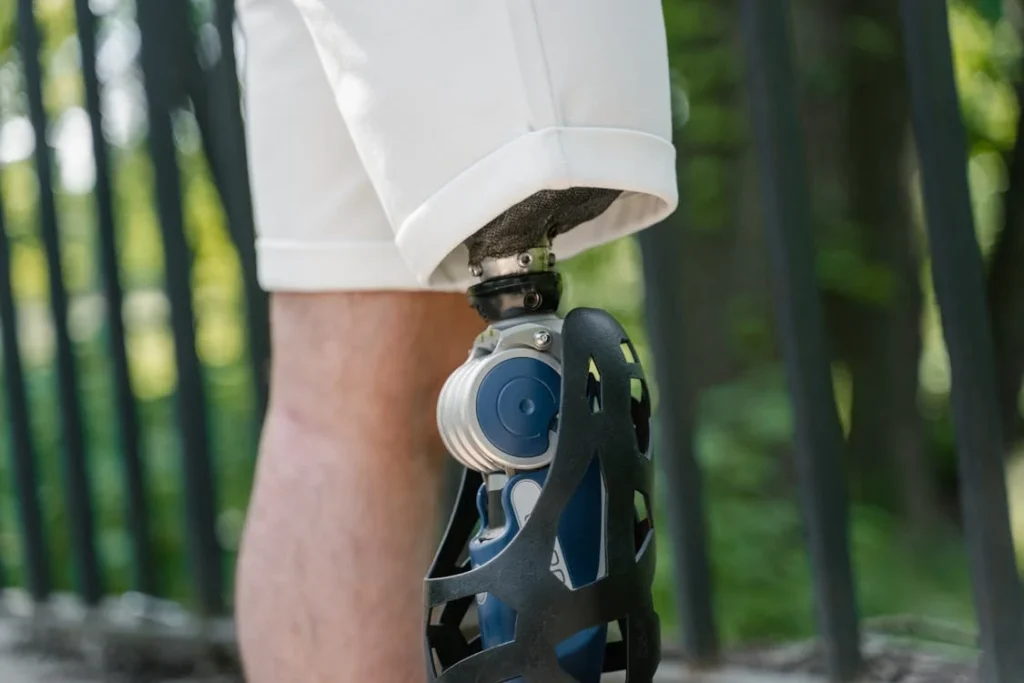
Why Socket Design Matters in Hemipelvectomy Prosthetics
When someone has a lower-limb amputation below the knee or even above the knee, the socket typically fits around the thigh. But with a hemipelvectomy, the entire leg and part of the pelvis are missing. That means there’s no thigh, no hip joint, and no standard shape to anchor the prosthetic.
Everything depends on how well the socket supports the torso, especially around the remaining side of the pelvis and lower back.
This is why socket design is not just about comfort—it’s about safety, alignment, and function. A well-designed socket helps the body stay upright, keeps the prosthetic from shifting, and allows smooth and balanced movement. A poorly designed socket can cause pain, skin problems, and even falls.
At Robobionics, we’ve seen how small changes in socket shape and material can have a big effect on the way someone walks or even how long they can stay mobile in a day. Our goal is to make every socket a custom fit—not just to the body, but to the life the person wants to live.
Understanding the Body After Hemipelvectomy
After a hemipelvectomy, the body no longer has its full natural symmetry. One side is shorter, lighter, and missing the strong base that a pelvis and leg usually provide. This creates a challenge when trying to maintain balance and keep the spine and shoulders aligned.
The body’s center of gravity shifts. That affects how someone stands, walks, and even how they sit. Without a supportive socket, the body starts to lean or twist. Over time, that leads to back pain, fatigue, or joint strain.
The socket must hug the body firmly—but not too tightly—around the remaining pelvis, waist, and sometimes the ribs. It should feel like a stable platform, not a burden. The design must support the body’s weight evenly so pressure points don’t build up.
When this happens correctly, walking becomes smoother, sitting becomes easier, and day-to-day tasks feel less exhausting.
We always begin by studying the person’s body shape, how they move, and where they need the most support. From there, we begin shaping a socket that matches their exact build. No two sockets we create at Robobionics are ever the same.
Custom vs. Off-the-Shelf: Why Personalization Matters
There are off-the-shelf socket systems available, but they’re not ideal for hemipelvectomy amputees. These generic sockets are made with standard shapes, assuming that most bodies are similar. But in hemipelvectomy cases, the body shape is far from standard.
Each person heals differently. Some have more tissue left on one side. Others might have scars, sensitive skin, or irregular bone structure.
Using a generic socket often leads to problems like slipping, pinching, or pressure sores. The discomfort can be so strong that users avoid wearing the prosthetic altogether. That’s the last thing we want.
Custom socket design allows us to work around every unique shape, scar, or sensitivity. We use 3D scanning and pressure mapping to measure exactly where the body needs support and where it needs relief. We adjust for body type, movement style, and lifestyle needs.
A person who wants to be active outdoors might need a firmer, more stable fit. Someone focused on daily household movement might need more flexibility.
This kind of design work takes time, care, and clear communication with the user. But the results are worth it. With the right socket, a hemipelvectomy prosthetic becomes more than a tool—it becomes part of the body.
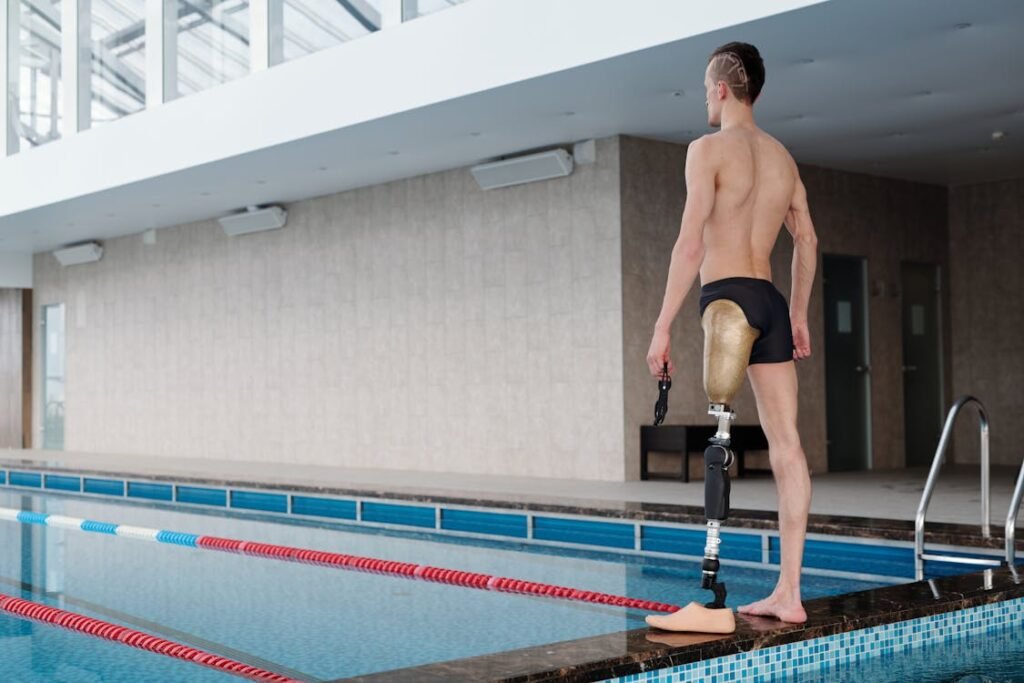
The Technical Challenges of Hemipelvectomy Socket Design
Designing a socket for a hemipelvectomy prosthetic isn’t just about making a mold and building around it. It involves deep technical understanding of how the human body works without one of its key weight-bearing structures.
The pelvis is not only the anchor for the leg—it’s also the central point for how force moves through the body. Without it, the body needs a new system of support that redistributes this load carefully and safely.
At Robobionics, we’ve spent years developing techniques and using advanced tools to overcome these challenges. We combine hands-on craftsmanship with digital precision to make sockets that are stable, secure, and built for real-world movement.
Managing Load Distribution
One of the first challenges we face is load distribution. With no leg or hip joint on one side, the entire weight-bearing job shifts to the remaining side of the body. If the socket doesn’t manage that force correctly, the user may develop sores, muscle fatigue, or even spinal misalignment.
Over time, this can lead to long-term health problems.
To avoid this, our designs focus on spreading the load across stronger, more durable areas of the body—like the lower back, the remaining pelvic bone, and the abdomen. This requires thoughtful shaping and material choice.
Some areas of the socket must be firm to carry weight; others must be softer to allow flexibility and comfort during motion.
We use smart layering techniques and adaptive materials that bend, cushion, and respond to the body’s movement. This allows the socket to move with the user instead of pushing against them.
This balance between support and flexibility is especially important for those who want to use their prosthetic throughout the day, at work, or while traveling.
Achieving Secure Suspension
Suspension refers to how the prosthetic stays connected to the body. For below-knee or above-knee amputees, suspension is usually managed around the thigh. But in hemipelvectomy cases, there’s no thigh. The entire weight of the prosthetic leg, knee, and foot must hang from the torso.
This brings up another major challenge—how to keep the socket in place without it sliding down or causing discomfort. We often use a combination of waist belts, suction systems, and molded pelvic shapes to achieve this.
These methods must be tested and refined with the user’s feedback. What works in the clinic might not feel right after a full day of walking or standing.
The goal is to create a socket that locks in securely during movement, but also allows the user to sit, bend, and rest without pain. Every curve and angle of the socket must take these real-life actions into account. That’s why our design team works closely with both the user and the rehabilitation therapist.
We gather feedback constantly and use it to tweak the design until it feels just right.
Keeping the Socket Lightweight Without Sacrificing Strength
Another technical issue is weight. Hemipelvectomy prosthetics include a full leg system, sometimes with a mechanical knee and foot. Adding a heavy socket on top of that can make the prosthetic feel bulky and tiring to use. But if the socket is too light and thin, it might not offer the support the user needs.
This is where our use of 3D printing and advanced polymers makes a real difference. We can create sockets with internal structures that are strong yet light. We reinforce high-pressure zones without adding bulk and keep the design clean, compact, and ergonomic.
This gives users more comfort and control while reducing the strain on their spine and shoulders.
When someone wears a well-made socket, they don’t have to think about it every time they move. That’s the level of comfort and function we aim for. It’s not just about mechanics—it’s about freedom.
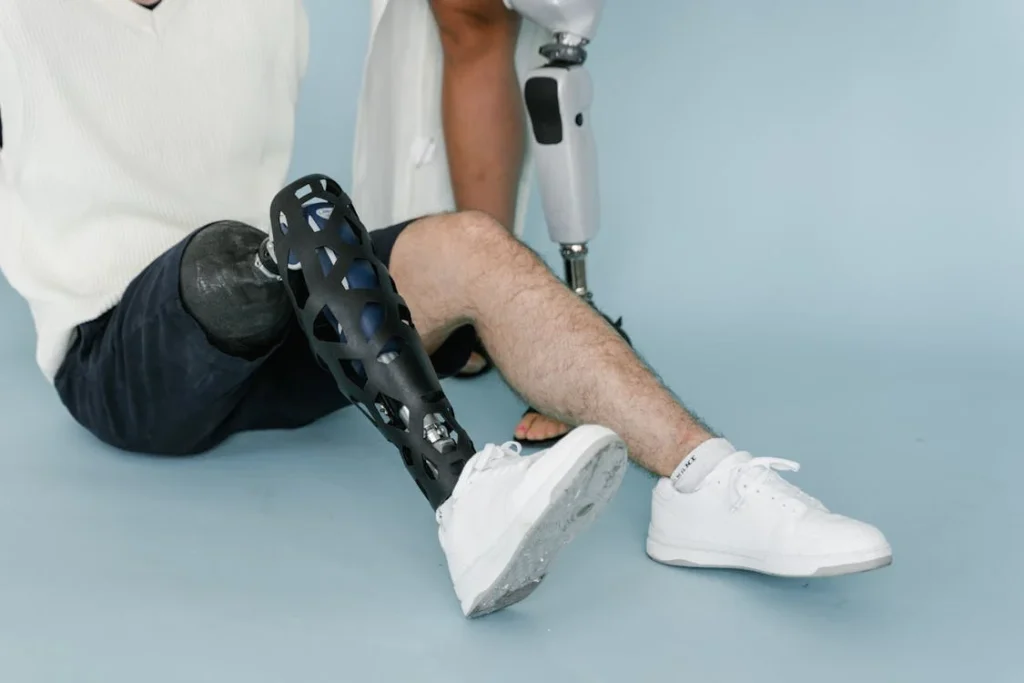
How Custom Socket Design Improves Mobility and Confidence
The real success of any prosthetic is measured not in how advanced it looks, but in how well it helps the person live their life.
For hemipelvectomy amputees, mobility doesn’t just mean walking—it means moving with ease, trusting the body again, and not thinking twice before doing simple tasks like getting out of a chair, reaching for something, or going for a walk outside. A well-designed socket plays a huge role in making that possible.
At Robobionics, we’ve seen how a custom socket can become the turning point in someone’s recovery. When the socket fits right, everything else begins to fall into place. Balance improves. Pain reduces. The fear of falling starts to fade. And slowly, confidence returns.
Comfort That Encourages Daily Use
If a socket is uncomfortable, a user will avoid wearing their prosthetic. This is a common issue we hear from patients who come to us after trying generic or poorly fitted sockets elsewhere. They say the prosthetic feels heavy, unstable, or simply doesn’t feel like a part of their body.
But with a custom design made just for their body, the change is often immediate. The socket feels secure, the edges don’t dig into the skin, and there’s no awkward shifting while walking. This encourages the user to wear the prosthetic for longer periods.
More wear means more walking. More walking means stronger muscles, better balance, and faster progress in rehabilitation.
Our goal is to make sockets that people want to wear—not just for rehab sessions but for daily life. Whether it’s at home, at work, or outside, we make sure the design supports real-world movement and long-term comfort.
Support for a Natural Gait Pattern
Walking after a hemipelvectomy is a complex task. Without a hip joint, the body has to find new ways to swing the leg forward and keep the upper body steady. A well-designed socket helps with this by holding the torso in alignment and giving the prosthetic leg a strong base to move from.
The better the alignment, the more natural the gait feels. Instead of having to lift the leg high or swing the body too far to the side, the person can walk with a smoother rhythm. This reduces fatigue, protects the spine, and prevents long-term joint stress.
Over time, a strong and stable gait pattern leads to greater independence. Users start to rely less on walking aids like crutches or walkers. Some are even able to manage short distances indoors without any support at all. That’s a huge milestone—and one that starts with the right socket.
Rebuilding Self-Esteem and Social Confidence
Physical movement is only one part of the journey. The emotional side of mobility is just as important. Many hemipelvectomy amputees struggle with feeling “different” or worried about how they move in public.
If their prosthetic is clunky or causes visible discomfort, they may start to avoid social situations altogether.
A socket that fits well and moves naturally helps reduce that worry. It allows users to focus on their activities, not their prosthetic. This has a big impact on self-esteem. When you can walk into a room without feeling unstable or out of place, your entire outlook changes.
At Robobionics, we take pride in creating prosthetics that do more than restore function. We help people feel whole again. From the first fitting to the final adjustments, we listen to our users, work around their lives, and design for both movement and confidence.
If you’re ready to experience the difference a custom socket can make, reach out to us for a consultation or visit one of our partner clinics like Omnify Prosthetics. We’ll guide you through every step—from evaluation to full fitment—with care, patience, and expert support.
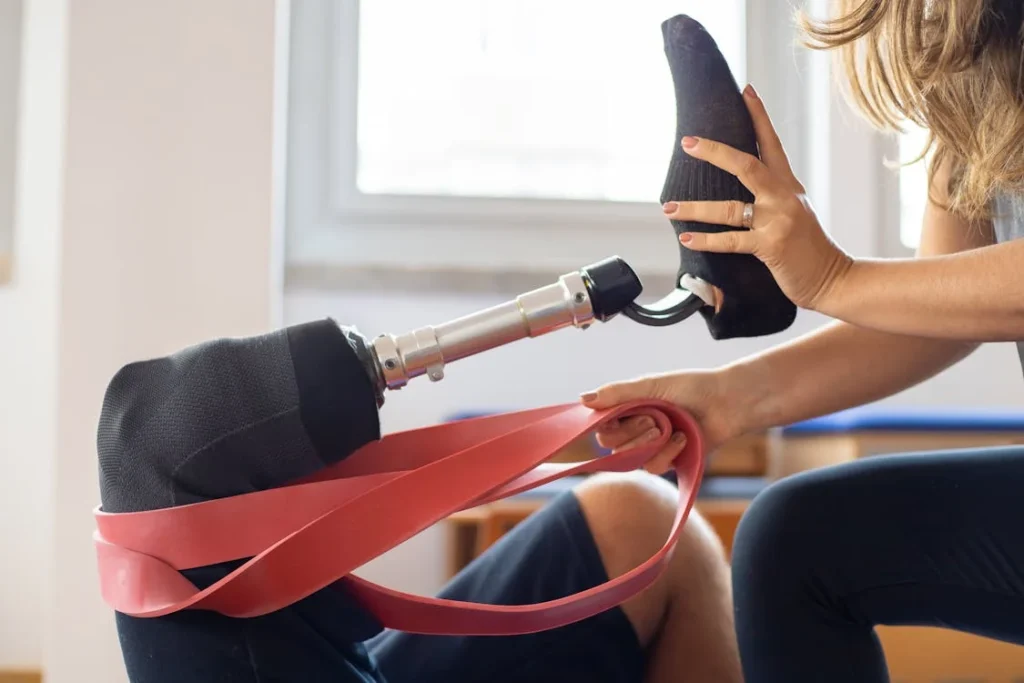
Collaboration Between User, Clinician, and Prosthetist in Socket Design
One of the most important, yet often overlooked, parts of creating a custom hemipelvectomy socket is teamwork. A successful prosthetic socket doesn’t come from technology alone—it comes from the collaboration between the user, the prosthetist, and the rehabilitation team.
Each person plays a key role in making sure the final design supports not just the body, but the lifestyle and goals of the person wearing it.
At Robobionics, we believe that the user is not a patient—they’re a partner in the process. We listen, we observe, and we adjust. Every socket we make is shaped not just by measurement tools, but by real conversations and feedback.
Listening to the User’s Body and Experience
The user knows their body better than anyone. They know when something feels off, when a certain pressure point hurts, or when they’re afraid to take a step. That kind of feedback is gold during the design process.
In every fitting, we ask simple questions: How does this feel? Where is the pressure strongest? Can you sit comfortably? Are you confident standing in this? Sometimes users can’t explain things in medical terms—and they shouldn’t have to.
We speak in everyday language and look for signs of discomfort, hesitation, or instability. Then we make the changes that matter.
This loop of test, feedback, and refine continues until the socket feels like it belongs.
The Role of the Prosthetist
The prosthetist is the bridge between design and real-life use. They translate body measurements and movement patterns into a shape that can carry weight, provide comfort, and allow motion.
In hemipelvectomy cases, this work is extremely detailed. The prosthetist must balance opposing needs—firmness and flexibility, security and freedom.
They also help train the user on how to put on and take off the socket correctly, how to clean it, and how to spot signs of pressure issues early. A great socket that isn’t worn correctly can still cause discomfort.
That’s why we never rush this stage. Every user leaves our clinic with not just a prosthetic, but a full understanding of how to use it with confidence.
At Robobionics, our prosthetists are also trained to work closely with therapists and doctors. They understand the importance of muscle recovery, spinal alignment, and emotional readiness.
This whole-body approach makes the socket not just a mechanical fit, but a lifestyle match.
Therapist Support and Functional Integration
Rehabilitation therapists help translate the benefits of a good socket into daily movement. They train the body to move safely with the prosthetic, help correct posture habits, and support the user in building balance and strength.
Therapists also help flag socket issues that might not show up during fitting sessions. If a user is limping, walking unevenly, or struggling with fatigue, the therapist can often tell whether it’s a gait issue or a socket issue. Their insights help the prosthetist fine-tune the design even more.
This kind of feedback loop—between user, prosthetist, and therapist—is what turns a good socket into a great one. It’s not about perfection on day one. It’s about building something better over time, with care and communication.
If you’re looking for a team that works with you, not just on you, Robobionics is ready to help. Schedule a free demo or consultation with us and see how we design prosthetics with people, not just for them.

The Importance of Follow-Up and Adjustments in Socket Longevity
A custom socket is never truly finished. Even the most carefully designed hemipelvectomy socket needs to evolve over time. The human body is dynamic—it changes with age, activity level, weight fluctuations, and even emotional stress.
What fits well today might feel tight, unstable, or uncomfortable a few months down the line. That’s why consistent follow-up care and timely adjustments are critical parts of long-term success.
At Robobionics, we treat the delivery of a custom socket as the beginning of a partnership—not the end of a transaction. We encourage our users to return for routine check-ins, because ongoing comfort and function depend on staying proactive.
Why the Body’s Shape Keeps Changing
After a hemipelvectomy, the body continues to adapt. Muscle mass on the remaining side can increase with training or reduce with inactivity. Swelling, scar tissue, and soft tissue volume can shift as healing progresses.
Even posture can change as the user learns new movement patterns. These changes can all impact how the socket fits against the torso, pelvis, and lower back.
Sometimes the changes are subtle. A user might start noticing redness on the skin after walking longer distances or feel uneven pressure while sitting. Other times, the shift can be more obvious—such as pain while standing, increased fatigue, or even reduced balance.
These are not signs that the prosthetic is failing. They’re signs that the socket needs to be tuned to fit the body’s current state.
Small changes in padding, contour, or strap position can often resolve these issues quickly and prevent them from becoming bigger problems later.
What Happens During an Adjustment Visit
When users return to us for a check-up, we begin by listening. We ask how daily life is going, whether they’ve experienced any discomfort, and how confident they feel while walking. We watch them move, take note of posture, and look at the skin for any signs of pressure or irritation.
If something needs to be adjusted, we do it on the spot whenever possible. Our in-house technicians can reshape socket edges, change suspension components, or add pressure relief areas within the same session.
If the body has changed more significantly, we may do a full re-evaluation and create a new socket shell altogether.
The goal is to avoid disruptions in the user’s mobility. We want our clients to stay active, feel supported, and never fear that their prosthetic might hold them back.
Encouraging Long-Term Use and Satisfaction
One of the main reasons some people stop using their hemipelvectomy prosthetic is that the socket stops fitting properly, and they don’t know where to turn. That’s why we make follow-up care simple and accessible.
Because we design and manufacture our prosthetics locally here in India, our users don’t have to wait weeks or months for help. They can get faster service, clearer communication, and expert care close to home.
This ease of support also encourages users to wear their prosthetic consistently. Instead of “saving it for special occasions,” they feel confident using it every day. That consistency helps improve gait, increase strength, and support emotional well-being.
If your socket isn’t feeling quite right—or if you’ve been avoiding your prosthetic altogether—it might be time for an expert adjustment.
Get in touch with Robobionics to schedule a follow-up visit or remote consultation. We’re here to keep you moving, comfortably and confidently, no matter how your journey evolves.
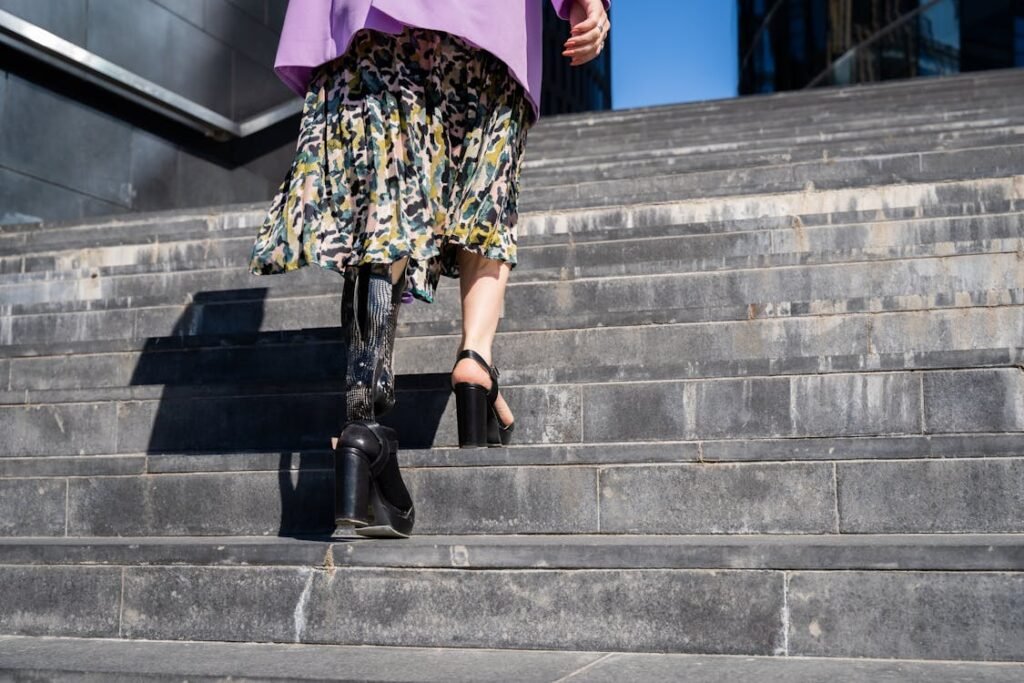
Innovations in Socket Materials and Fabrication Techniques
The field of prosthetics is evolving rapidly, and one of the most exciting areas of progress is in how sockets are made. For hemipelvectomy prosthetics, where comfort, durability, and weight matter more than ever, material innovation plays a major role in improving user outcomes.
Traditional materials like heavy plastics and rigid composites are gradually being replaced by smarter, lighter, and more adaptive options. These changes aren’t just technical—they’re deeply practical. They help people move better, feel more comfortable, and use their prosthetic more confidently.
At Robobionics, we’ve invested in modern technologies like 3D printing and advanced polymers because we’ve seen the difference they make firsthand. For users living with complex amputations, these materials often mean the difference between just wearing a prosthetic and truly living with it.
The Shift Toward Lightweight Materials
One of the biggest challenges with hemipelvectomy sockets is weight. Since the prosthetic system includes a full leg—sometimes with a mechanical knee and foot—the socket must be as light as possible without losing strength. Heavier sockets lead to fatigue, slower movement, and increased strain on the spine and shoulders.
That’s why newer materials like carbon-reinforced polymers, flexible thermoplastics, and high-strength nylon blends are becoming more popular. These materials offer high durability with minimal bulk. They don’t crack or warp easily and are far more breathable than older alternatives.
When a socket is lighter, the user notices it instantly. Walking becomes smoother. The prosthetic swings with better rhythm. Balance improves. And most importantly, the socket feels less like a burden and more like a part of the body.
The Role of 3D Printing in Precision Fit
Custom sockets used to require weeks of manual molding, plaster casting, and physical adjustments. While this method can still work, it often leads to inconsistencies in fit and longer wait times. With 3D printing, we can scan a user’s body digitally, design the socket with extreme accuracy, and print a prototype within days.
This digital process allows us to test different socket shapes quickly, make fast changes, and get the final fit right much faster. The precision of 3D printing means the socket hugs the body’s contours exactly, reducing pressure points and slippage.
It also gives us the ability to create internal structures—like honeycomb grids or pressure relief zones—that would be impossible with traditional materials.
This level of customization improves both comfort and confidence. When the socket fits just right from day one, the user can begin training and rehabilitation without delay, building strength and mobility early in the process.
Material Choices for Skin Health and Temperature Control
Hemipelvectomy sockets wrap around the torso, sometimes extending to the ribs or abdomen. These areas are sensitive and often sweat more than limbs. That’s why the materials we choose must also help with temperature regulation and skin care.
Modern sockets now include antibacterial linings, moisture-wicking layers, and soft interface materials that prevent chafing and overheating.
These details may seem small, but they can make the difference between wearing the prosthetic for a few hours versus all day.
For users in warm and humid regions—like much of India—these features are essential. At Robobionics, we design sockets that fit not only your body, but your environment too.
If you’re interested in exploring a next-generation socket built with today’s most advanced materials, we invite you to consult with our design team.
Discover how innovative socket design can give you better comfort, lighter movement, and stronger confidence in every step.
Conclusion
For someone living with a hemipelvectomy, the socket is more than just a connection to a prosthetic—it’s the foundation for movement, comfort, and independence. When designed correctly, a custom socket supports the body, aligns posture, reduces strain, and allows the user to move with confidence. From shaping around unique body contours to using advanced materials and precision technologies, every detail matters.
At Robobionics, we treat socket design as a craft rooted in care. We combine medical insight, user feedback, and cutting-edge tools to deliver solutions that feel natural, secure, and built for everyday life. Whether you’re just starting your rehabilitation or revisiting your current fit, our team is here to help.
Don’t settle for discomfort or limited movement. Schedule a personalized consultation or book a free demo with Robobionics today and experience the power of a socket built just for you. Let’s rebuild strength, restore confidence, and take every step forward—together.



